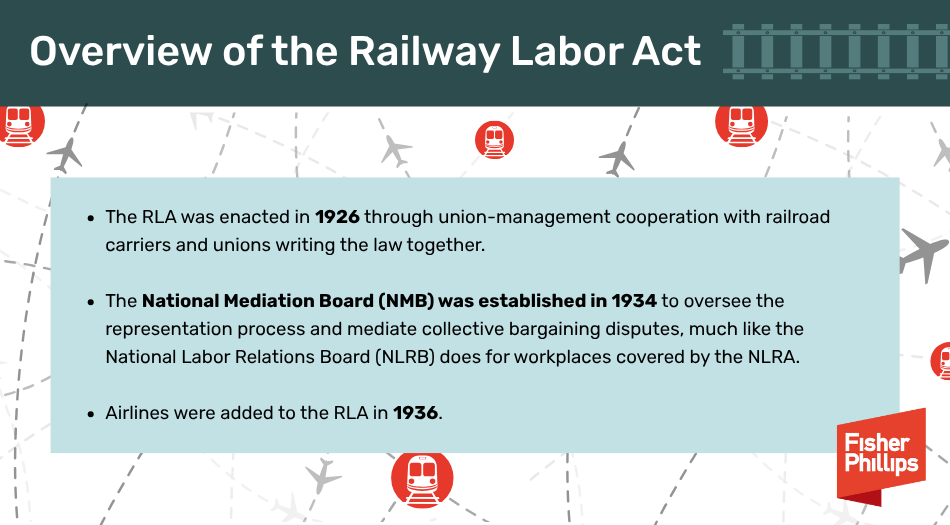The Railway Labor Act: A Practical Guide For Employers In Air And Rail Transportation
Insights
6.17.25
While most employers in the U.S. must comply with the National Labor Relations Act (NLRA), employers in the railroad and airline industries need to understand the Railway Labor Act (RLA) and how its unique requirements impact covered carriers. Whether you’re new to the industry or need a refresher, here are the answers to your key questions about how the RLA impacts your operations and how it differs from the NLRA.
|
Quick Overview
|
Who Is Covered By The RLA?
- While the NLRA covers most private sector employers, plus the U.S. Postal Service, the RLA covers carriers by air and rail, as well as derivative carriers on the rail side.
- Until recently, “derivative carriers” (non-carriers that are controlled by a carrier) were covered under the RLA on both the air and the rail side.
- In a recent case, however, the NMB determined that there is no such thing as a “derivative carrier” on the airline side. Only air carriers themselves are under RLA jurisdiction, and all others fall under the NLRA.
- On the rail side, the derivative carrier standard applies to organizations that are controlled by an RLA carrier if:
- the duties it performs are normally performed by rail employees (this is the “functional test”); and
- the rail carrier significantly controls the day-to-day operations of the purported derivative carrier (this is the “control test”).
What Are Some Key Differences Between The RLA And NLRA?
- The heart of the NLRA is Section 7, which guarantees employees the right to:
- self-organization;
- form, join, or assist labor organizations;
- bargain collectively through representatives of their own choosing; and
- engage in other concerted activities, such as strikes, for the purpose of collective bargaining or other mutual aid or protection.
- The heart of the RLA, by contrast, involves dispute resolution and avoiding interruptions to interstate commerce. For example, both parties must first “exert every reasonable effort to make and maintain agreements concerning rates of pay, rules, and working conditions, and to settle all disputes, whether arising out of the application of such agreements or otherwise, in order to avoid any interruption to commerce or to the operation of any carrier growing out of any dispute between the carrier and the employees thereof.”
- While the NLRB does not have a formal role in helping parties reach an agreement, the NMB has a complex and specific procedure, and parties must exhaust those procedures before turning to self-help (such as strikes and lockouts).
- In other words: The NLRA provides the parties autonomy when negotiating agreements, including the right to self-help. By contrast, the process under RLA Section 6 has strict statutory guidelines, with the NMB providing oversight for a significant portion of the process.
- Grievance procedures, particularly on the rail side, often differ from those under the NLRA, with the NMB having an administrative role in the railroad industry. Airline grievance procedures are closer to those often found under the NLRA.
How Do Workers’ Rights Compare?
- As compared to the NLRA, unions and workers have fewer statutory rights under the RLA, and change happens slower. Essentially, the RLA is a minimalist statute, whereas the NLRA aims to address the many nuances of labor law.
- Statutory rights under the RLA are particularly limited after a union’s certification. However, protections like Weingarten rights (the right of a union-represented employee to have a representative at an investigatory interview where discipline may result) may be incorporated into the collective bargaining agreement (CBA) and enforced through the grievance process.
How Does Union Organizing And Representation Differ?
- While bargaining units under the NLRA can be small – and the presumption is that a single facility bargaining unit is appropriate – bargaining units under the RLA consist of systemwide crafts and classes (such as pilots, flight attendants, mechanics, conductors, or engineers).
- “Subordinate officials” or lower-level supervisors can be represented by the union under the RLA.
- A union must have a 50% showing of interest (signatures of those interested in a union) under the RLA compared to 30% under the NLRA in order to apply/petition for an election. The election will be determined by a majority of the votes under either law.
- It is difficult to overstate the importance of the CBAs under the RLA.
- Under the RLA, CBAs do not expire but become amendable, and the bargaining process has been described as “interminable.”
What Options Do Carriers Have During The Self-Help Period?
- Carriers may permanently replace, but not discharge, strikers. In contrast to the NLRA, there is no unfair labor practice (ULP) strike under the RLA, as there are no ULPs at all. Under the NLRA, ULP strike status would permit only temporary replacements.
- In most cases, a carrier will not have to discharge permanent replacements or crossovers (strikebreakers or “scabs” in union parlance) to make room for strikers following the termination of the strike.
- A carrier may unilaterally implement proposed changes that were subject to negotiation during the major dispute process. Unions may seek to enjoin changes that were not sought in CBA negotiations under RLA Section 6.
- Notably, the legality of lockouts during the self-help period is unresolved under the RLA.
What Options Do Unions Have During The Self-Help Period?
- Unions can organize strikes, including traditional strikes, intermittent strikes, selective strikes (strikes against some but not all carriers in a multiemployer group), and partial strikes (withholding the performance of some duties such as a collective refusal to fly “open time”).
- Picketing is another option, including secondary picketing, which would violate the NLRA (by targeting employers other than the ones involved in the dispute).
- Unions are often blocked when they seek to engage in strike activity outside of the RLA’s parameters.
Are Strikes Common In RLA Disputes?
- Strikes can be easily protected under the NLRA, even in a non-union setting, absent a “no-strike, no lockout” provision during the term of the CBA. However, it is difficult to strike legally under the RLA without going through a lengthy dispute resolution program, which is controlled by the NMB.
- Thus, the point of the RLA is for the parties to settle disputes among themselves in order to avoid interruption to commerce. The RLA values “stability in labor relations” above most other considerations.
What Is Involved In The RLA Dispute Resolution Process?
- The process begins with the parties exchanging notices of the general subjects they’d like to address during bargaining.
- The parties then may bargain directly without assistance.
- If either or both parties desire mediation, they contact the NMB and complete an application, and a mediator is assigned. This differs from the FMCS process under the NLRA, as both parties do not have to agree.
- The NMB may proffer voluntary but binding interest arbitration to resolve remaining contractual terms. If declined, a 30-day cooling-off period begins.
- A Presidential Emergency Board (PEB) may be convened, which is essentially a public, non-binding interest arbitration.
- Thirty days after the PEB report is issued to the President, the parties may engage in self-help unless Congress takes action.
What Is The Difference Between A Major And Minor Dispute Under The RLA?
- Major and minor disputes are handled differently under the RLA.
- Those disputes concerning an intended change in rates of pay, rules, or working conditions are major disputes. They arise out of the formation of collective agreements or the efforts to secure them. They look toward the acquisition of rights for the future, not whether rights have vested in the past.
- U.S. district courts are empowered to enjoin changes when they find disputes to be major.
- Minor disputes are essentially grievances brought before “system boards” or “adjustment boards,” meaning RLA arbitration tribunals.
- The US Supreme Court has attempted to provide additional guidance on whether disputes are major or minor. Under SCOTUS precedent, the dispute is minor if the action is arguably justified by the terms of the CBA. However, if the carrier’s claims are frivolous or obviously insubstantial, it is a major dispute. Other case law has determined this is a matter of degree.
What Role Do Courts Play In Disputes?
- The NMB and the NLRB differ in this regard. The NLRB oversees unfair labor practices, historically with courts deferring to the Board’s expertise (which may be different in a post-Chevron analysis). Typically, however, the NLRB would not acquiesce to federal appeals court decisions it did not like.
- By contrast, the NMB has no role with respect to RLA statutory rights, which must be enforced in federal court. Notably, the case law from the federal circuits varies, and occasionally those differences are significant.
Conclusion
For air and rail employers, understanding the unique aspects of the RLA is essential for creating an effective labor relations strategy. We will continue to monitor issues impacting these industries. Make sure you are subscribed to Fisher Phillips’ Insight System to get the most up-to-date information delivered to your inbox. If you have questions, contact your Fisher Phillips attorney, the authors of this Insight, or any attorney in our Labor Relations Practice Group or on our Transportation and Supply Chain Industry Team.
Law clerk Katy Houshidari contributed to this Insight.
Related People
-
- Brian Casal
- Partner
